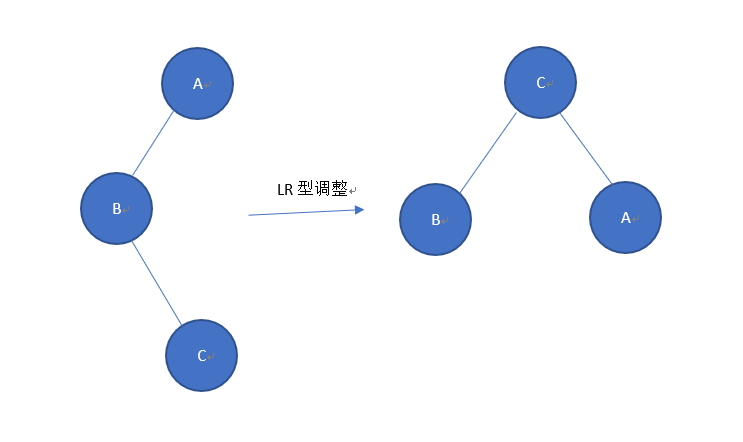1. 简介
平衡二叉树(Balanced Binary Tree)具有以下性质:它是一棵空树或它的左右两个子树的高度差的绝对值不超过1,并且左右两个子树都是一棵平衡二叉树。平衡二叉树的常用实现方法有红黑树、AVL、替罪羊树、Treap、伸展树等。 其中最为经典当属AVL树,我们
总计而言就是:平衡二叉树是一种二叉排序树,其中每一个结点的左子树和右子树的高度差至多等于1。
2. 性值
AVL树具有下列性质的二叉树(注意,空树也属于一种平衡二叉树):
l 它必须是一颗二叉查找树
l 它的左子树和右子树都是平衡二叉树,且左子树和右子树的深度之差的绝对值不超过1。
l 若将二叉树节点的平衡因子BF定义为该节点的左子树的深度减去它的右子树的深度,则平衡二叉树上所有节点的平衡因子只可能为-1,0,1.
l 只要二叉树上有一个节点的平衡因子的绝对值大于1,那么这颗平衡二叉树就失去了平衡。
3.实现:
AVL树的构建我们需要明白一个核心的操作,整个实现过程是通过在一棵平衡二叉树中依次插入元素(按照二叉排序树的方式),若出现不平衡,则要根据新插入的结点与最低不平衡结点的位置关系进行相应的调整。各个调整的方法分为LL型、RR型、LR型和RL型4种类型,其余的操作与一般的树进行插入和修改数据无异,这里由于篇幅关系不做过多缀数,以其中一种LR型调整为例说明,其余各种也都是举一反三思考:

由于在A的左孩子(L)的右子树(R)上插入新结点,使原来平衡二叉树变得不平衡,此时A的平衡因子由1变为2。图5是LR型的最简单形式。显然,按照大小关系,结点C应作为新的根结点,其余两个节点分别作为左右孩子节点才能平衡。
①将B的左孩子C提升为新的根结点
②将原来的根结点A降为C的右孩子
③各子树按大小关系连接(BL和AR不变,CL和CR分别调整为B的右子树和A的左子树)。
4. 代码演示:
代码仅作参考,具体实现请根据实际情况修改:
#include<stdio.h>
#include<stdlib.h>
//结点设计
typedef struct Node {
int key;
struct Node *left;
struct Node *right;
int height;
} BTNode;
int height(struct Node *N) {
if (N == NULL)
return 0;
return N->height;
}
int max(int a, int b) {
return (a > b) ? a : b;
}
BTNode* newNode(int key) {
struct Node* node = (BTNode*)malloc(sizeof(struct Node));
node->key = key;
node->left = NULL;
node->right = NULL;
node->height = 1;
return(node);
}
//ll型调整
BTNode* ll_rotate(BTNode* y) {
BTNode *x = y->left;
y->left = x->right;
x->right = y;
y->height = max(height(y->left), height(y->right)) + 1;
x->height = max(height(x->left), height(x->right)) + 1;
return x;
}
//rr型调整
BTNode* rr_rotate(BTNode* y) {
BTNode *x = y->right;
y->right = x->left;
x->left = y;
y->height = max(height(y->left), height(y->right)) + 1;
x->height = max(height(x->left), height(x->right)) + 1;
return x;
}
//判断平衡
int getBalance(BTNode* N) {
if (N == NULL)
return 0;
return height(N->left) - height(N->right);
}
//插入结点&数据
BTNode* insert(BTNode* node, int key) {
if (node == NULL)
return newNode(key);
if (key < node->key)
node->left = insert(node->left, key);
else if (key > node->key)
node->right = insert(node->right, key);
else
return node;
node->height = 1 + max(height(node->left), height(node->right));
int balance = getBalance(node);
if (balance > 1 && key < node->left->key) //LL型
return ll_rotate(node);
if (balance < -1 && key > node->right->key) //RR型
return rr_rotate(node);
if (balance > 1 && key > node->left->key) { //LR型
node->left = rr_rotate(node->left);
return ll_rotate(node);
}
if (balance < -1 && key < node->right->key) { //RL型
node->right = ll_rotate(node->right);
return rr_rotate(node);
}
return node;
}
//遍历
void preOrder(struct Node *root) {
if (root != NULL) {
printf("%d ", root->key);
preOrder(root->left);
preOrder(root->right);
}
}
int main() {
BTNode *root = NULL;
root = insert(root, 2);
root = insert(root, 1);
root = insert(root, 0);
root = insert(root, 3);
root = insert(root, 4);
root = insert(root, 4);
root = insert(root, 5);
root = insert(root, 6);
root = insert(root, 9);
root = insert(root, 8);
root = insert(root, 7);
printf("前序遍历:");
preOrder(root);
return 0;
}C语言网提供由在职研发工程师或ACM蓝桥杯竞赛优秀选手录制的视频教程,并配有习题和答疑,点击了解:
一点编程也不会写的:零基础C语言学练课程
解决困扰你多年的C语言疑难杂症特性的C语言进阶课程
从零到写出一个爬虫的Python编程课程
只会语法写不出代码?手把手带你写100个编程真题的编程百练课程
信息学奥赛或C++选手的 必学C++课程
蓝桥杯ACM、信息学奥赛的必学课程:算法竞赛课入门课程
手把手讲解近五年真题的蓝桥杯辅导课程